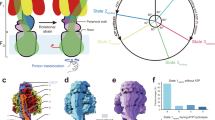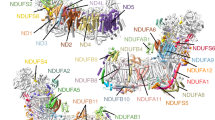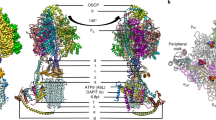Abstract
Mitochondrial adenosine triphosphate (ATP) synthase uses the proton gradient across the inner mitochondrial membrane to synthesize ATP. Structural and single molecule studies conducted mostly at neutral or basic pH have provided details of the reaction mechanism of ATP synthesis. However, pH of the mitochondrial matrix is slightly acidic during hypoxia and pH-dependent conformational changes in the ATP synthase have been reported. Here we use single-particle cryo-EM to analyze the conformational ensemble of the yeast (Saccharomyces cerevisiae) ATP synthase at pH 6. Of the four conformations resolved in this study, three are reaction intermediates. In addition to canonical catalytic dwell and binding dwell structures, we identify two unique conformations with nearly identical positions of the central rotor but different catalytic site conformations. These structures provide new insights into the catalytic mechanism of the ATP synthase and highlight elastic coupling between the catalytic and proton translocating domains.
This is a preview of subscription content, access via your institution
Access options
Access Nature and 54 other Nature Portfolio journals
Get Nature+, our best-value online-access subscription
$29.99 / 30 days
cancel any time
Subscribe to this journal
Receive 12 print issues and online access
$189.00 per year
only $15.75 per issue
Buy this article
- Purchase on Springer Link
- Instant access to full article PDF
Prices may be subject to local taxes which are calculated during checkout





Similar content being viewed by others
Data availability
Three-dimensional cryo-EM density maps of the yeast mitochondrial ATP synthase in nanodiscs have been deposited in the Electron Microscopy Data Bank (EMDB) under accession numbers EMD-29270, EMD-29278, EMD-28685, EMD-28687, EMD-28689, EMD-28809, EMD-28811, EMD-28813, EMD-28814, EMD-28835, EMD-28836, EMD-28837, EMD-29250 and EMD-29251. The corresponding atomic coordinates for the atomic models have been deposited in the PDB under accession numbers 8FL8, 8F29, 8F39 and 8FKJ (Table 1). PDB 6CP6 was used as an initial model for model building. Source data are provided with this paper.
References
Xu, T., Pagadala, V. & Mueller, D. M. Understanding structure, function, and mutations in the mitochondrial ATP synthase. Micro. Cell 2, 105–125 (2015).
Srivastava, A. P. et al. High-resolution cryo-EM analysis of the yeast ATP synthase in a lipid membrane. Science 360, 6389 (2018).
Walker, J. E. The ATP synthase: the understood, the uncertain and the unknown. Biochem. Soc. Trans. 41, 1–16 (2013).
Boyer, P. D. A perspective of the binding change mechanism for ATP synthesis. FASEB J. 3, 2164–2178 (1989).
Walker, J. E. & Dickson, V. K. The peripheral stalk of the mitochondrial ATP synthase. Biochim. Biophys. Acta 1757, 286–296 (2006).
Soga, N. et al. Perfect chemomechanical coupling of F0F1-ATP synthase. Proc. Natl Acad. Sci. USA 114, 4960–4965 (2017).
Wachter, A. et al. Two rotary motors in F-ATP synthase are elastically coupled by a flexible rotor and a stiff stator stalk. Proc. Natl Acad. Sci. USA 108, 3924–3929 (2011).
Junge, W., Sielaff, H. & Engelbrecht, S. Torque generation and elastic power transmission in the rotary F0F1-ATPase. Nature 459, 364–370 (2009).
Guo, H. & Rubinstein, J. L. Structure of ATP synthase under strain during catalysis. Nat. Commun. 13, 2232 (2022).
Murphy, B. J. et al. Rotary substates of mitochondrial ATP synthase reveal the basis of flexible F1-F0 coupling. Science 364, eaaw9128 (2019).
Zhou, A. et al. Structure and conformational states of the bovine mitochondrial ATP synthase by cryo-EM. eLlife 4, e10180 (2015).
Noji, H., Yasuda, R., Yoshida, M. & Kinosita, K. Jr. Direct observation of the rotation of F1-ATPase. Nature 386, 299–302 (1997).
Steel, B. C. et al. Comparison between single-molecule and X-ray crystallography data on yeast F1-ATPase. Sci. Rep. 5, 8773 (2015).
Nishizaka, T. et al. Chemomechanical coupling in F1-ATPase revealed by simultaneous observation of nucleotide kinetics and rotation. Nat. Struct. Mol. Biol. 11, 142–148 (2004).
Adachi, K. et al. Coupling of rotation and catalysis in F1-ATPase revealed by single-molecule imaging and manipulation. Cell 130, 309–321 (2007).
Sobti, M., Ueno, H., Noji, H. & Stewart, A. G. The six steps of the complete F1-ATPase rotary catalytic cycle. Nat. Commun. 12, 4690 (2021).
Abrahams, J. P. et al. Structure at 2.8 Å resolution of F1-ATPase from bovine heart mitochondria. Nature 370, 621–628 (1994).
Suzuki, K. et al. Crystal structures of the ATP-binding and ADP-release dwells of the V1 rotary motor. Nat. Commun. 7, 13235 (2016).
Jault, J. M. et al. Alteration of apparent negative cooperativity of ATPase activity by alpha-subunit glutamine 173 mutation in yeast mitochondrial F1. Correlation with impaired nucleotide interaction at a regulatory site. J. Biol. Chem. 266, 8073–8078 (1991).
Moore, K. J. & Fillingame, R. H. Obstruction of transmembrane helical movements in subunit a blocks proton pumping by F1F0 ATP synthase. J. Biol. Chem. 288, 25535–25541 (2013).
Moore, K. J. & Fillingame, R. H. Structural interactions between transmembrane helices 4 and 5 of subunit a and the subunit c ring of Escherichia coli ATP synthase. J. Biol. Chem. 283, 31726–31735 (2008).
Yanagisawa, S. & Frasch, W. D. Protonation-dependent stepped rotation of the F-type ATP synthase c-ring observed by single-molecule measurements. J. Biol. Chem. 292, 17093–17100 (2017).
Yanagisawa, S. & Frasch, W. D. pH-dependent 11° F1FO ATP synthase sub-steps reveal insight into the FO torque generating mechanism. eLife 10, e70016 (2021).
Nakane, T., Kimanius, D., Lindahl, E. & Scheres, S. H. Characterisation of molecular motions in cryo-EM single-particle data by multi-body refinement in RELION. eLife 7, 145–160 (2018).
Sobti, M. et al. Cryo-EM structures provide insight into how E. coli F1FO ATP synthase accommodates symmetry mismatch. Nat. Commun. 11, 2615 (2020).
Kabaleeswaran, V. et al. Novel features of the rotary catalytic mechanism revealed in the structure of yeast F1 ATPase. EMBO J. 25, 5433–5442 (2006).
Martin, J. L. et al. Anatomy of F1-ATPase powered rotation. Proc. Natl Acad. Sci. USA 111, 3715–3720 (2014).
Mnatsakanyan, N. et al. The role of the betaDELSEED-loop of ATP synthase. J. Biol. Chem. 284, 11336–11345 (2009).
Luo, M. et al. Bedaquiline inhibits the yeast and human mitochondrial ATP synthases. Commun. Biol. 3, 452 (2020).
Martin, J. L. et al. Elastic coupling power stroke mechanism of the F1-ATPase molecular motor. Proc. Natl Acad. Sci. USA 115, 5750–5755 (2018).
Arsenieva, D. et al. Crystal structures of mutant forms of the yeast F1 ATPase reveal two modes of uncoupling. J. Biol. Chem. 285, 36561–36569 (2010).
Greene, M. D. & Frasch, W. D. Interactions among gamma R268, gamma Q269, and the beta subunit catch loop of Escherichia coli F1-ATPase are important for catalytic activity. J. Biol. Chem. 278, 51594–51598 (2003).
Okazaki, K. & Hummer, G. Elasticity, friction, and pathway of gamma-subunit rotation in FoF1-ATP synthase. Proc. Natl Acad. Sci. USA 112, 10720–10725 (2015).
Sgarbi, G. et al. The role of the ATPase inhibitor factor 1 (IF1) in cancer cells adaptation to hypoxia and anoxia. Biochim. Biophys. Acta Bioenerg. 1859, 99–109 (2018).
Gledhill, J. R. et al. How the regulatory protein, IF1, inhibits F1-ATPase from bovine mitochondria. Proc. Natl Acad. Sci. USA 104, 15671–15676 (2007).
Cabezon, E. et al. Modulation of the oligomerization state of the bovine F1-ATPase inhibitor protein, IF1, by pH. J. Biol. Chem. 275, 25460–25464 (2000).
Fujii, S. et al. pH-Induced conformational change of ATPase inhibitor from yeast mitochondria. A proton magnetic resonance study. J. Biochem. 93, 189–196 (1983).
Rouslin, W. Factors affecting the reactivation of the oligomycin-sensitive adenosine 5′-triphosphatase and the release of ATPase inhibitor protein during the re-energization of intact mitochondria from ischemic cardiac muscle. J. Biol. Chem. 262, 3472–3476 (1987).
Rouslin, W. Regulation of the mitochondrial ATPase in situ in cardiac muscle: role of the inhibitor subunit. J. Bioenerg. Biomembr. 23, 873–888 (1991).
Penefsky, H. S. A centrifuged-column procedure for the measurement of ligand binding by beef heart F1. Methods Enzymol. 56, 527–530 (1979).
Palovcak, E. et al. A simple and robust procedure for preparing graphene-oxide cryo-EM grids. J. Struct. Biol. 204, 80–84 (2018).
Schorb, M. et al. Software tools for automated transmission electron microscopy. Nat. Methods 16, 471–477 (2019).
Sharma, S. et al. Mechanism of LolCDE as a molecular extruder of bacterial triacylated lipoproteins. Nat. Commun. 12, 4687 (2021).
Zheng, S. Q. et al. MotionCor2: anisotropic correction of beam-induced motion for improved cryo-electron microscopy. Nat. Methods 14, 331–332 (2017).
Rohou, A. & Grigorieff, N. CTFFIND4: fast and accurate defocus estimation from electron micrographs. J. Struct. Biol. 192, 216–221 (2015).
Ru, H. et al. Molecular mechanism of V(D)J recombination from synaptic RAG1-RAG2 complex structures. Cell 163, 1138–1152 (2015).
Scheres, S. H. RELION: implementation of a Bayesian approach to cryo-EM structure determination. J. Struct. Biol. 180, 519–530 (2012).
Emsley, P. et al. Features and development of Coot. Acta Crystallogr. D. Biol. Crystallogr. 66, 486–501 (2010).
Adams, P. D. et al. PHENIX: a comprehensive Python-based system for macromolecular structure solution. Acta Crystallogr. D. Biol. Crystallogr. 66, 213–221 (2010).
Pettersen, E. F. et al. UCSF Chimera–a visualization system for exploratory research and analysis. J. Comput. Chem. 25, 1605–1612 (2004).
Pettersen, E. F. et al. UCSF ChimeraX: structure visualization for researchers, educators, and developers. Protein Sci. 30, 70–82 (2021).
Acknowledgements
The project was supported by a grant from the National Institutes of Health, no. R35GM131731, to D.M.M. Cryo-EM data for ATP synthase at pH 6 were collected at Stanford-SLAC Cryo-EM Center (S2C2), which is supported by the National Institutes of Health Common Fund Transformative High-Resolution Cryo-Electron Microscopy program (grant no. U24 GM129541). Cryo-EM data for ATP synthase in presence of Mg:ATP were collected at the National Center for Cryo-EM Access and Training and the Simons Electron Microscopy Center located at the New York Structural Biology Center, supported by the National Institutes of Health Common Fund Transformative High-Resolution Cryo-Electron Microscopy program (grant no. U24 GM129539) and by grants from the Simons Foundation (grant no. SF349247) and NY State Assembly. M. Liao is an investigator of SUSTech Institute for Biological Electron Microscopy.
Author information
Authors and Affiliations
Contributions
D.M.M. and M. Liao conceived and supervised the project. H.P. expressed, purified and reconstituted ATP synthase into lipid nanodiscs. M. Luo and S.S. prepared cryo-EM samples and collected data. S.S. processed cryo-EM data and built models. S.S., M. Liao and D.M.M. analyzed the data and wrote the paper with input from all authors.
Corresponding authors
Ethics declarations
Competing interests
The authors declare no competing interests.
Peer review
Peer review information
Nature Structural & Molecular Biology thanks Alain Dautant and the other, anonymous, reviewer(s) for their contribution to the peer review of this work. Peer reviewer reports are available. Primary Handling Editor: Katarzyna Ciazynska, in collaboration with the Nature Structural & Molecular Biology team.
Additional information
Publisher’s note Springer Nature remains neutral with regard to jurisdictional claims in published maps and institutional affiliations.
Extended data
Extended Data Fig. 1 Cryo-EM of ATP synthase in presence of Mg:ATP.
A, Representative micrograph (from a dataset of 4219 images) of ATP synthase in lipid nanodiscs under continuous ATP hydrolysis. B, Two-dimensional class averages of F1Fo. C, Image processing workflow of the dataset (see Methods for details). D, Local resolution (left) and angular distribution (right) of the consensus and focused maps. E, Fourier shell correlation (FSC) between the half maps with resolution at FSC = 0.143 indicated. F, Model for yeast ATPase in the rotational state 2 (pdb ID 6CP6) fit into the map for the minor conformation (20% of particle images), with sectional view showed in G. Consensus map (H) and model (I) of the major conformation. J, Sectional view (as observed from the membrane) of the major conformation (ribbon) overlaid with the structure of bovine ATP synthase in rotational state 1 (pdb ID 5ARA) depicted as transparent surface. In panels G and J, the rotational angle of the central rotor is designated by a black arrow. “CR” refers to central rotor.
Extended Data Fig. 2 Cryo-EM image processing workflow.
A, Representative micrograph (from a dataset of 19,744 images) of ATP synthase in lipid nanodiscs at pH 6. B. 2D class averages of F1Fo C, Image processing workflow resulting in cryo-EM maps for Conf-0 (green), Conf-1 (red). D, Image processing workflow focused on F1 resulting in cryo-EM maps for Conf-1 (red) and Conf-2 (blue). E, Fo-centered image processing workflow resulting in cryo-EM maps for Conf-0 (green) and Conf-3 (pink). “CR” refers to central rotor.
Extended Data Fig. 3 Analysis and Statistics of Cryo-EM maps.
Local resolution (left) and angular distribution (right) of Conf-1 consensus map (A), Conf-1 F1 focused map (B), Conf-1 Fo + CR (central rotor) focused map (C) and Conf-1 Fo-focused map (D). E, Fourier shell correlation (FSC) between the half maps for Conf-1 with resolution at FSC = 0.143 indicated. Local resolution (left) and angular distribution (right) of Conf-2 consensus map (F), Conf-2 F1-focused map (G) and Conf-1 Fo + CR focused map (H). I, Fourier shell correlation (FSC) between the half-maps for Conf-2 with resolution at FSC = 0.143 indicated. Local resolution (left) and angular distribution (right) of Conf-3 consensus map (J), and Conf-3 Fo + CR focused map (K). L, Fourier shell correlation (FSC) between the half-maps for Conf-3 with resolution at FSC = 0.143 indicated.
Extended Data Fig. 4 Representative density from high-resolution maps.
Cryo-EM density from high-resolution maps with the corresponding model fit into the density for Conf-1 (A) and Conf-2 (B).
Extended Data Fig. 5 Comparison of observed conformations at pH 6 with existing catalytic and binding dwell structures.
A, Sectional view across F1 of Conf-0 (pdb ID 6CP6) fit into the map of bovine ATP synthase in State 2 (EMD-3166). B, Sectional view across F1 of Conf-0 showing catalytic site conformations and rotational angle of the central rotor (indicated with gray arrow) similar to catalytic dwell structures of Bacillus PS3 (pdb ID 7LIR) (C) and Sc (pdb ID 7TKR) (D). E. Sectional view across F1 of Conf-3 showing catalytic site conformations and rotational angle of the central rotor similar to binding dwell structures of Bacillus PS3 (pdb ID 7L1Q) (F) and Sc (pdb ID 7TKM) (G). H, Sectional view across F1 of Conf-1 with catalytic sites conformations consistent with binding dwell but rotational angle of the central rotor is not. I, Sectional view across F1 of Conf-2 with catalytic sites conformatio consistent with catalytic dwell but rotational angle of the central rotor is not. Rotational angle of the central rotor in each structure is indicated by gray arrows and the rotation from catalytic dwell to binding dwell to Conf-1 and Conf-2, is indicated in blue. Sc refers to Saccharomyces cerevisiae.
Extended Data Fig. 6 Comparison of the a/c interface between Conf-1 and Conf-2.
Cryo-EM map and model from Fo domain’s a/c interface in Conf-1 (A) and Conf-0 (pdb ID 6CP6 fit into the map for Conf-0) (B). The pdb chain IDs of individual c-subunits have been labeled (letters K-T). C, Overlay of Conf-1 (blue) and Conf-0 (green).
Extended Data Fig. 7 Structure of the F1 domain from Conf-1 docked into the map for Conf-3.
A, Cryo-EM map for conf-3. B, Model for F1 domain and peripheral stalk in Conf-1 docked into the corresponding cryo-EM density for Conf-3 (transparent), shown here as a sectional view.
Extended Data Fig. 8 Comparison of the a/c interface between Conf-1 and Conf-3.
Comparison of the model from Fo domain’s a/c interface between conf-1 (A) and conf-3 (B). The pdb chain IDs for individual c-subunits have been denoted as letters (K-T).
Supplementary information
Supplementary Video 1
Conformational transition from Conf-0 to Conf-1. The animation shows a morph from Conf-0 to Conf-1 with subunits color coded as in the main text figures.
Supplementary Video 2
Conformational transition from Conf-1 to Conf-2. The animation shows a morph from Conf-1 to Conf-2 with subunits color coded as in the main text figures.
Supplementary Video 3
Conformational transition from Conf-1 to Conf-3. The animation shows a morph from Conf-1 to Conf-3 with subunits color coded as in the main text figures.
Source data
Source Data Extended Data Fig. 2
Source data for Extended Data Fig. 2a: uncropped micrograph of ATP synthase in lipid nanodiscs.
Rights and permissions
Springer Nature or its licensor (e.g. a society or other partner) holds exclusive rights to this article under a publishing agreement with the author(s) or other rightsholder(s); author self-archiving of the accepted manuscript version of this article is solely governed by the terms of such publishing agreement and applicable law.
About this article
Cite this article
Sharma, S., Luo, M., Patel, H. et al. Conformational ensemble of yeast ATP synthase at low pH reveals unique intermediates and plasticity in F1–Fo coupling. Nat Struct Mol Biol 31, 657–666 (2024). https://doi.org/10.1038/s41594-024-01219-4
Received:
Accepted:
Published:
Issue Date:
DOI: https://doi.org/10.1038/s41594-024-01219-4



